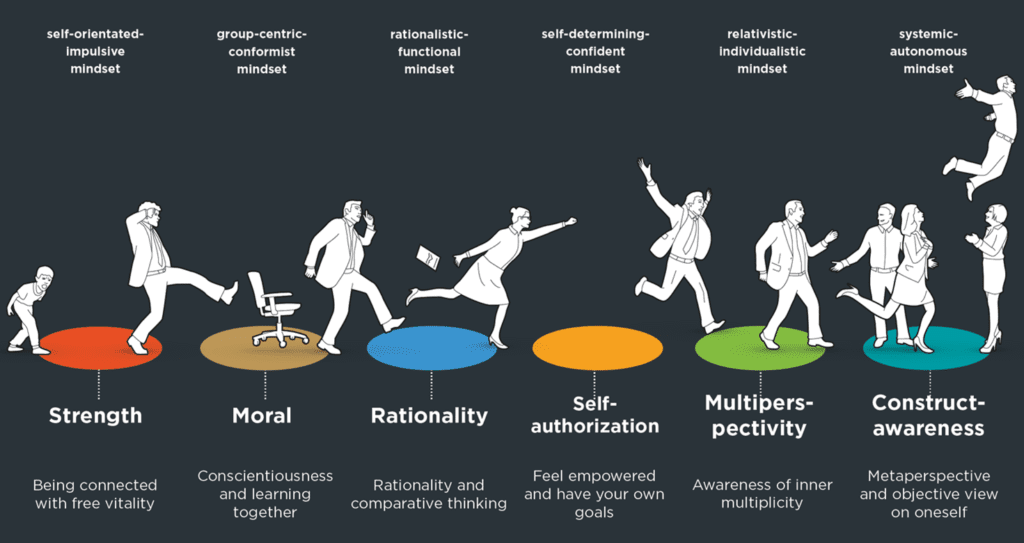8 Perspectives on Deep Inner Work –
The Path for Personal and Professional Growth
The Path for Personal and Professional Growth
Part 2 of 8: Moving into Higher Mindsets
October 12, 2022
This is part two of an eight-part series on deep inner work at Evolute Institute. For the other parts check out:
- Article 1: Increasing our inner freedom
- Article 2: Moving into higher mindsets
- Article 3: From disconnection to re-connection & addressing trauma
- Article 4: Healing Psychological Wounding and the Work of Grief
- Article 5: Overcoming Cultural Conditioning
- Article 6: Increasing Psychological Flexibility
- Article 7: Fostering Integration through and beyond psychedelic work
- Article 8: Acquiring Wisdom for a Good Life
Shaping our personal and collective future through mindsets
A mindset is the attitude or mental model of a person that underlies their actions, objectives, opinions and beliefs. It determines how a person deals with their own impulses, instincts and the ethical standards they adopt for their actions. It shapes how they deal with other people, social groups, situations and ideas.[1] Summarising one could say a mindset is like an “operating system” of a person.
History and the recent geo-political developments have taught us that cultures as well as individuals can develop and act out of different mindsets, which in turn fundamentally determine our perspective on the world. The way we view the world does not only impact how our personal lives evolve but also how history unfolds. Individuals matter, and our mindset matters.
So if we want understand the actions both by murderous dictators and populist presidents on the one hand, and by people from the opposite end of the spectrum like Mahatma Ghandi or Nelson Mandela, mindsets offer us a frame of reference, and also give us a language to talk about how people are and behave in the world.

Photo by Andrea De Santis on Unsplash
So in this second article of our eight-part series on inner work, let us take a look at what mindsets are, how they can be modeled through scientific insights and how we can use this knowledge to move into more advanced, humane, and life-affirming mindsets. What different mindsets do exists and how can they be characterized?
Our mindset: the lens through which we see the world
Martin Permantier’s mindset model has proven itself to be very useful when talking about personal, leadership and even collective mindset development[2]. It integrates decades of scientific research by pioneers in the field of developmental psychology such as Abraham Maslow, Erik Erikson, Jean Piaget, Jane Loevinger, Robert Keagan. In addition, Martin Permantier’s model encompassed the developmental stage models from other leading thinkers, such as Clare Graves, Don Beck with his Spiral Dynamics approach, Ken Wilber with his Integral Model, Susanne Cook-Greuter with her Ego Development Theory (EDT) or Frederic Laloux who earned his reputation in business and organizational circles with his work on “re-inventing organizations”[3]. Permantier’s model is a synthesis of the work of these developmental pioneers into a beautifully visualized framework of 6 mindsets that are differentiated into different areas of development: into individual mindsets, leadership mindsets, collaboration mindsets, organizational culture mindsets, and societal mindsets. Figure 1 illustrates, for example, that our mindset shapes how we understand leadership and how we work together.
Fig. 1: Our mindsets shapes how we understand leadership and how we work together. Cf. Permantier, M. (2019): Mindset Matters, Vahlen Verlag.
So how does mindset development happen?
According to developmental psychology, at least in an optimal scenario, throughout our lives, we usually undertake a developmental journey towards higher degrees of differentiation and integration. This means that we all start at a simple and less sophisticated mindset as children (e.g. our world is limited to ourselves and our needs) and gradually – with countless trials and errors along the way – we progress towards more complex mindsets. Our horizon progressively expands beyond ourselves and can contain more of the complexities of the world around us.
However, before we dive into the details of how distinct mindset are characterized, there are a few caveats to be mentioned: First, the path of psychological development varies considerably across individuals. While some people will develop very quickly and steeply, others might stagnate and unlikely move beyond their status quo. Second, once our brain has reached its “neurological maturity” (a brain of a toddler functions differently compared to a brain of a 20-year-old), mindset development is, to a large extent, a process that needs to be initiated voluntarily either by self-motivation and / or by a stimulating environment (e.g. school, parents, friends and colleagues, coaches, spiritual teachers etc.).
Catalysts for growth: growth by choice vs. crises

Photo by Jametlene Reskp on Unsplash
This means that the individual needs to willfully and consciously engage in and expose herself to new situations in order to learn and grow. Sometimes, a window for developmental leaps is opened up by life confronting us with unforeseen challenges, e.g. the sudden death of a beloved person or a fate-changing accident that leaves us physically impaired. But most of the times, if we do not actively strive for it, development probably will not occur.
These two caveats carry important implications: We all have to start at the beginning, i.e. the lowest mindset, and are only able to experience the next higher mindset once we have fully embodied and grown too big for our current mindset. This is why there is no hierarchy of good and bad mindsets – we rely on the learnings from each and every mindset to be able to move on to the next one at some point.
Furthermore, in a given society, there will always be a statistical distribution of mindsets, usually with only a minority of people being in the highest mindsets. Similarly, there is no guarantee that an individual will ever experience highest-level mindsets. And even if we experience the grace of being in a highest-level mindset, development is a perpetual path of differentiation and integration that never reaches an endpoint. To think otherwise is to assume that we cannot any longer learn from the world and that we have already solved the mystery of our existence.
Understanding the 6 mindsets model
Fig. 2: Inner development viewed through the lens of mindsets. Cf. Permantier, M. (2019): Mindset Matters, Vahlen Verlag.
Bearing the above-mentioned factors in mind, we can now devote some time to understand how Martin Permantier actually describes the six different developmental mindsets. Of course this can only be a teaser of the full mindset model that we dive deeper into as part of our personal and leadership development programs. In the end mindsets need to be experienced, not just read about.
The conventional mindsets
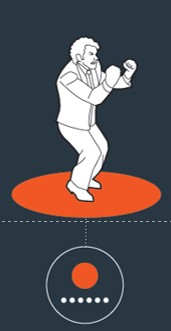
When we are in a self-orientated impulsive mindset (red), it is all about survival/security and about winning, along the lines of “I exert force and pressure to get what I want. The others are stupid or unimportant and it is all about me and what I need.” This is the world of a mafia-like organization, but it is not hard to find prominent examples of such leadership styles when looking at the current stage of international political affairs – it is the dominant mindsets of the Trumps and Putins of the world. It’s all or nothing, and I resort to lies, threats and aggression to get what I want. This is all good when we are three years old and have our tamper tantrum phase but highly dangerous when we occupy positions of responsibility and power. Some people get stuck in this mindset when they have not received enough love or protection from their primary caregivers and others in earlier years, have been rejected, shamed, punished or abandoned, and feel deeply inadequate and insecure deep within. They do everything to not feel weak, projecting their inadequacies onto others and also abusing others. A surprising number of CEOs and heads of state have made it to the top with such a self-orientated impulsive mindset – they are leaders without compassion and empathy, and without respect for rules or the common good.
In the group-centric conformist mindset (brown), the main focus is about tasks – “we do as we are told, there is a strict top-down hierarchy, and my personal needs do not matter”. Preferences and needs of individuals are subsumed under the overall organization’s goals, think of the military apparatus or a large bureaucracy. Obedience is the order of the day, and objections, personal opinions or constructive feedback are not welcome. Responsibility is repudiated and a culture of risk avoidance prevails. For example, Putin, a former KGB agent who underwent the strictly hierarchical upbringing of Soviet Russia’s national security agencies, has also established and reinforced a strictly hierarchical political leadership mindset.
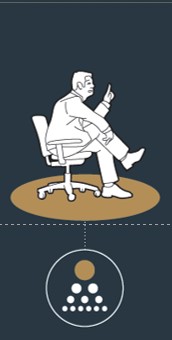

In the rationalistic functionalist mindset, we lead with numbers and logic. All relevant decision-making factors have to fit into an excel sheet. We apply the rational, analytic mind to organize our world for maximum efficiency, optimizing everything according to standardized processes. The financial bottom-line is the only arbiter of truth. The organization is supposed to be a well-oiled machine, with the employees as the replaceable cogs that have to function and achieve their goals in order to maintain order and stability.
Most of today’s business corporations and organizational principles of our economies in the West are based on or dominated by such a rationalistic functionalist mindset. Subjects and objects have no intrinsic value other than what can be attributed by market pricing mechanisms. For instance, the value of clearing a pristine forest is determined by the combined market price of the resources that can be exploited from it, e.g. the timber, soil, and riches extracted from the soil. More “advanced” policies would maybe factor in externalities like the economic damage resulting from a decrease in biodiversity, e.g. a reduced rate of crop pollination due to a decline in the bee population that lived in the forest. However, the intrinsic value of having a healthy variety of flora and fauna, of being surrounded by and connected to a vibrant web of life, would not find space in these edifices of pragmatic and abstracted calculus (see our forthcoming article on the imbalances of our left and right brain hemispheres).
Advancing to the self-determining confident mindset (orange), people start to move from control as a cognitive operator towards empowerment. “You still receive business goals, but you are flexible as to how to achieve them. It is about thinking by yourself and doing your own thing”. The guiding motto is that you are the architect of your own fortune. Prestige, status and wealth are considered important social indicators of success. People feel comfortable in displaying their achievements and the social narrative of climbing up “from rags to riches” is deeply engrained in people’s worldview and in corresponding organizational structures. About two thirds of organizations in the West operate according to the rationalistic-functional or self-determining confident mindset.
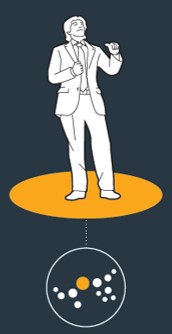
Post-conventional mindsets
After having transcended the first four mindsets – the so-called conventional mindsets – the next stages consist of the post-conventional mindsets:
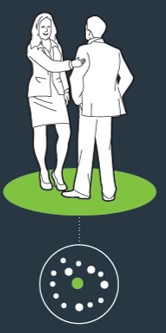
In the relativistic-individualistic mindset (green), we integrate emotional intelligence into our leadership and organizations. We start becoming aware of our personal shadows and do not constantly assume anymore that we are right. We gain enough perspective to realize that the world is not revolving around us. We begin working together based on strengths in diverse and inclusive teams, and we lead with values in a self-aware and emotionally-informed manner.
The 6th and – at least for now – final mindset is the systemic autonomous one (turquoise). When we operate from this mindset, meaning and purpose become the dominant cognitive operators. We focus on the long-term, on personal growth, personal integrity and accountability as well as systemic thinking. Our interests shift to co-creation, exchanges at eye-level and an awareness of the constructedness of the self, of society, of all our fundamental building blocks of reality emerges. Paradoxes and inner tensions can be held and integrated into a life that is guided by an inner compass. Leaders like Nelson Mandela or Mahatma Ghandi were mostly living from this mindset.

What we and the world around us gain with higher mindsets
The upward movement of personal and leadership development is one of “including and transcending” – we go through life by inhabiting (at least) one stage of development, and when we have fully integrated its complexity into our system and the right conditions are present (e.g. supportive social surrounding, coaching, a personal mentor, a new emotional reference experience followed by intentional integration work on our side…) we can move ahead to the next stage (see Figure 3).
For instance, we ascend from the self-orientated-impulsive mindset (red), in which we believe we are the center of the earth (think Donald Trump), where stimulus and reaction are very close to each other, where we are driven by outer influences and our inner impulses, to the group-centric conformist mindset (brown) by establishing order and rules. What a gain in freedom when we are no longer victims to our moods and impulses!
At the next level, we are using the critical mind to move to the rationalistic-functional mindset (blue), where we do not divide life into good and evil in a simplistic way any longer, but instead use our analytical mind to differentiate, understand, know, and act based on that knowledge.
Figure 3: Expanding our inner space by moving upwards the developmental path. From Permantier, Martin (2019): Mindset Matters, Vahlen Verlag.
When we empower ourselves (and allow for self-empowerment in others), we move to the self-determining mindset (orange) – what a relief to no longer be stuck in a mechanistic world of calculating cause-and-effect relationships!
Then, when we move to the relativistic individualistic mindset (green), we discover and make use of the power of empathy and compassion. Not because an empathic approach to other people helps us achieve our goals more quickly, but because we start seeing how much closer we can connect to life by opening up our hearts. In a similar way, we learn to appreciate and include diversity. We are no longer the puppets of our self-story that imprisoned us in the never-ending quest for recognition and status – what a liberation!
Finally, when we move to the systemic-autonomous mindset, we strive towards and find inner autonomy (see the first article of this series on increasing our inner freedom). We stop relativizing everything or losing ourselves in empathy for others, but let ourselves be guided by our own inner compass. In a nutshell, these are the movements of personal and leadership development towards greater inner autonomy and freedom.
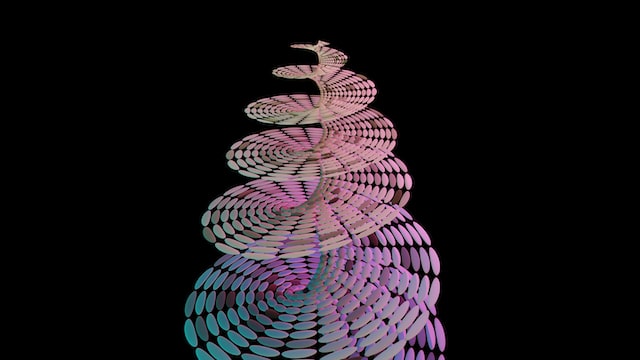
The mindset determines how we define good leadership
What makes for a good leader is perceived differently from each mindset. We grow from an exclusive focus on goal achievement (red) to include also the respect for rules and regulations (brown), to a focus on efficient structures and processes (blue), to an additional emphasis on a space for personal development for employees (orange). When we add a values-oriented and empathetic way of being with each other (green) and finally a responsibility for a long-term social and ecological compatibility (turquoise), we have integrated the two post-conventional mindsets as well. Each larger mindset does not replace the preceding ones but includes and transcends all them.
It is also important to know that every mindset is right in its own systems of fear and thought. Just telling other people they have the wrong mindset won’t get us anywhere. At the same time, the self-oriented impulsive mindset and the group-centric conformist mindset won’t get us anywhere in solving the complex global challenges we are facing as humanity. We need new models and higher mindsets to be able to see and appreciate our diversity within and between us. Developing these does not happen overnight and will take time.

Photo by Dmitriy Zub on Unsplash
Falling down the spiral – regression is always possible
Even if we have gained access higher mindsets in principle, it is possible we temporarily or permanently regress from the highest mindset available to us at any given moment. We usually fall back into lower mindsets when we are triggered by certain factors in our environment, especially by conflicts in relationships. For instance, our romantic partner criticizes us for not really listening to them. When we are overwhelmed with the situation and cannot summon our inner resources to adequately deal with it, then we first loose the sense for the big picture (turquoise), then our empathy (green), then our own critical thinking (blue), and finally our common sense and decency (we have successfully regressed to red, the self-orientated-impulsive mindset). Our awareness of our own mindset can help, of course, to witness our current mindsets, our shifts in our mindset and to gain the freedom to choose our mindset (“Haltung”) at any given moment. It is a perpetual journey of development.
The will to develop

Photo by Waren Brasse on Unsplash
So the question is of course: can you help other people develop, and move into higher mindsets? Well, the answer is: it depends. You cannot develop others if they do not want to develop – there needs to be a will to develop. This also means, while it would be great if world leaders started embarking on a journey of personal and leadership development, there is little reason for hope regarding individuals like Trump or Putin. If people do not see a need to develop themselves, they will probably remain stuck in the self-orientated impulsive mindset for the rest of their lives, and people operating from higher mindsets can only attempt to contain the damage for the time being.[4]
New emotional reference experiences: Helping leaders move into higher mindsets
If there is a will to develop, you can support people by creating safe and experimental spaces for development, by coaching and supervision, and by teaching people certain competencies, like radical acceptance, interrupting automatic thoughts and behaviour and using inner tension productively. Most importantly, people need to make new emotional reference experiences to access higher mindsets and new ways of being in the world.
In our work at Evolute Institute, we support people in experiencing higher mindsets – sometimes for the first time, sometimes in an expansionary and consolidating way:
- In order to experience and “be in” the relativistic-individualistic mindset, we assist leaders in recognizing their inner multiplicity (i.e. their different inner parts, inner “voices”) and in re-owning those parts that they have dis-owned (“shadow parts”). Equally, our experienced team of facilitators help them to align and to create coherence between their body, their feelings and their thoughts and to practice attunement on these three levels to others. Finally, when an individual can bring loving-kindness and compassion to her wounded parts (to understand how personality structure and our defense mechanisms form around wounds, stay tuned for our forthcoming articles) she can also develop more compassion for others.
- To empower people to experience and “be in” the systemic-autonomous mindset, we help leaders to clarify their values and renew their sense of life’s purpose by engaging in deep reflection as well as in radical honesty and self-compassion by entering altered states consciousness. The work in altered states of consciousness, such as breathwork, meditation, or using legal psilocybin truffles (for example as part of our personal and leadership development program EvoLEAD), enables people to develop a construct-awareness of their own self, in turn liberating them from their own automatic thinking and behavioral patterns. We also create a space where deep grief work, forgiveness, and redemption are invited to happen – where we can experience to be autonomous and connected at the same time, thus holding the ostensible tension between freedom and intimacy. Our defense mechanisms and numbness “melt” so that a new warmth and vitality can enter our personal and professional lives. Some participants even feel a connection with the transpersonal realm. This mind-expanding experience can guide us and give meaning to our lives despite of all the troubles and suffering in in our own lives and in the world around us.
The movement into these two higher mindsets (green and turquoise) creates inner alignment and inner space. To someone in a leadership position, this can translate into becoming more grounded, centered, responsive (response-able), and aligned with the world and her purpose. Leaders become less reactive or triggered, and less affected by the stresses of their demanding lives. Moreover, being in these higher mindsets makes it easier for leaders to let go of what cannot be changed, so that they have greater capacity to relate more deeply to others and hold space for them and their experience.

Photo by Michael Glazier on Unsplash
Summing up, we believe we can construct our own virtuous circle when approaching life from a certain perspective and mindset: inner work, outstanding leadership, and the “good life” are closely intertwined.
In the next article, we’ll look into deep inner work from a different perspective – why deep inner work means to move from disconnection to re-connection and how this relates to trauma:
In case you liked what you read and haven’t read article 1 of this 8-part series: check out the first of part of our article series on Deep inner work: How to increase inner freedom.
Christopher Kabakis
Contributing Author
Dmitrij Achelrod PhD
Christopher Kabakis
Contributing Author
Dmitrij Achelrod PhD
Subscribe to the insights newsletter
At most, once every 2 weeks.


Images
Article Cover: Photo by Jørgen Håland on Unsplash
References:
[1] Martin Permantier (2019): Mindset Matters – Shaping leadership and corporate culture for the future. Vahlen Verlag, p. 14
[2] Martin Permantier (2019): Mindset Matters – Shaping leadership and corporate culture for the future. Vahlen Verlag.
[3] Frederic Laloux (2014): “Reinventing Organizations: A Guide to Creating Organizations Inspired by the Next Stage in Human Consciousness: A Guide to Creating Organizations Inspired by the Next Stage of Human Consciousness.” Nelson Parker; 1. Edition.
[4] For a deep dive into how to beat right-wing populists from a communication point of view have a look at Christopher Kabakis’ TEDxWHU 2018 Talk: “Talk like Trump? Understanding populist speech and how to overcome it“


